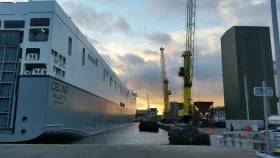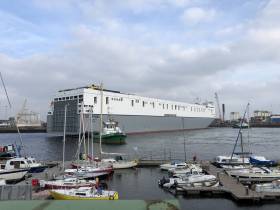Displaying items by tag: CLdN Ro Ro
Ro-Ro Freight-Ferry on Ireland-Belgium Route Towed to Safety after Losing Power Near Wolf Rock Lighthouse off Cornwall
A ro-ro freight-ferry which departed Cork Harbour lost power and ended up grounded near the Wolf Rock lighthouse off Cornwall, has been towed to safer waters off Falmouth.
The 31,140-tonne Mazarine operated by CLdN had sailed from Ringaskiddy and was bound for Zeebrugge, Belgium, however on Monday the ro-ro vessel when in the Celtic Sea became stranded near the Wolf Rock lighthouse nine miles off the coast of Cornwall.
According to the coastguard they were alerted to the situation of the 2009 built ro-ro at about 9.10am. Two lifeboats from the RNLI stations based at Sennen Cove and Penlee went to the scene of the grounding Maltese flagged vessel which has a 250 freight-trailer capacity.
During a passage of the Isle of Scilly ferry-cargoship Scillonian III from Penzance to the archipelago, the passenger ferry was alerted of the incident in case anyone needed to be evacuated.
In addition a coastguard helicopter was also deployed.
According to CornwallLive yesterday, 11 July, the 195m long vessel was re-floated and drifting for several hours under a lifeboat escort, with the ship towed by a tug to waters off Falmouth.
As BBC News also reported the Maritime and Coastguard Agency (MCA) said it would remain there while a decision was made on what to do next.
The Luxembourg based ship operator, CLdN Ro Ro S.A. said that all the 22 crew and three passengers on board the vessel were safe and unharmed.
More on the incident here.
Big Day Ahead As World's Largest Short-Sea RoRo Vessel MV Celine to be Christened In Dublin Port
#DublinPort - A big day awaits Dublin Port and major customer, CLdN ro ro SA as their newbuild MV Celine, the world's largest short-sea ro-ro ship arrived in the port today in advance of tomorrow's christening ceremony, writes Jehan Ashmore.
The giant MV Celine of 74,000 gross tonnage will be christened and adopted by her Godmother,Geraldine O'Reilly wife of Dublin Ports CEO Eamonn O'Reilly at a ceremony to be held at Ocean Pier within Alexandra Basin. This is where a purpose-built flexible ro-ro ramp linkspan was installed in recent months to accommodate the requirements of the 234m long Celine.
Since Celine's introduction in October, the ship has added considerable capacity for Irish exporters with greater flexibility by trading with markets in continental Europe, in particular, given the backdrop of post-Brexit. More recently a sister, Delphine, joined the service connecting Dublin with Rotterdam, Netherlands and Zeebrugge from where the ship arrived from Belgium this morning.
The new berth infrastructure in Dublin Port permits the unloading and discharging of Celine's impressive 8,000 freight lane metre capacity. In addition to 600 freight units, easily surpassing the largest Irish Sea ro-ro ferry currently operating through the port to the UK.
The sisters can handle a wide range of cargoes, unaccompanied trailers, tank containers, project cargo, new cars and a capacity for 12 driver accompanied units. The ro-ro ships will also include a North Sea link from Belgium to the UK. Luxembourg based CLdN ro-ro SA also operate an extensive route network linking mainland Europe with Scandinavia and Iberia.
The South Korean built Celine is a clear indicator of increasingly larger tonnage that is expected to use the port. Construction of phase one of the Dublin Port Masterplan is already underway with the Alexandra Basin Redevelopment (ABR) project that will enable larger ships to dock in port following dredging and realligned quays.
#DublinPort - The brand new Delphine made a maiden call to Dublin Port, the giant ship is a sister of leadship Celine, claimed to be the world’s largest short-sea ro-ro freightship, writes Jehan Ashmore.
The Celine of 74,000 gross tonnage is now equally partnered with Delphine's debut. The newbuild arrived from Zeebrugge, Belgium but firstly anchored in Dublin Bay to wait for Celine's departure from the port. This took place last Thursday evening.
The sisters operated by CLdN Ro Ro SA /Cobelfret Ferries serve the Rotterdam-Zeebrugge-Dublin route which is also connected to a UK port.
Delphine has an impressive 8,000 freight lane metres and can handle 600 freight units. The South Korean built Delphine boosts capacity to Celine and together provide Irish exporters with greater flexibility by trading with markets in continental Europe, particularly against the backdrop of post-Brexit.
Luxembourg based CLdN also offers connections from the European mainland, Scandinavia and Iberia.
Delphine's inaugural call to the Irish port's Alexandra Basin is from where the 234m ro-ro docked at the custom-built ro-ro ramp linkspan.
On the occasion of Celine's first call in October last year, the ship instead docked in Alexandra Basin (East). The change to the new ro-ro linkspan took place the next month allowing smaller fleetmates also serving to continue to use the adjacent basin facility.
The Maltese flagged Delphine has a beam of 35m and the cargo decks are all accessed through an aft vehicle loading/unloading ramp. Cargoes using the ship's ro-ro ramp includes unaccompanied trailers, tank containers, project cargo, new cars.
In addition accommodation is available for 12 driver accompanied units.






























































